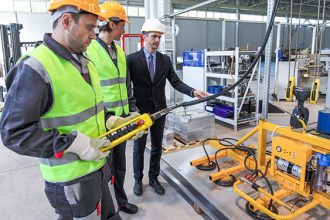Why Repeated Handling Of Small Work Pieces Can Harm Workers’ Backs As Much As Heavy Loads

While most operations acknowledge that manually lifting and moving a heavy object has a high risk of injuring a worker’s back, many don’t recognize that repeated movement of small items — day in and day out, shift after shift — also poses the same risk. That’s because a worker performing the same task over and over, such as manually building pallet loads of 30- to 40-pound cases fed to them from a conveyor line, will cumulatively accrue signs of wear in their spine. These repetitive stress injuries are caused by a worker performing too many uninterrupted repetitions of an activity or motion (lifting the case, twisting, and bending or reaching to place it on the pallet), potentially in an incorrect posture, leading to overexertion and muscle fatigue.
Indeed, the federal Bureau of Labor Statistics’ most recent data shows that the number one work-related musculoskeletal disorder — defined by the report as an injury caused by overexertion or repetitive motion and results in days away from work — among laborers, and freight, stock and material movers (hand) is to their back, at 43.0%. Their colleagues working as stock clerks and order fillers have even higher rates of back disorders, at 45.7%.
Therefore, in spite of the perception that there’s less risk of a back injury from moving lots of small loads, the statistics show otherwise. To protect workers and minimize the chance of harm resulting from repetitive stress, some operations mandate that their employees do not manually lift loads weighing more than 35 to 40 pounds; others have gone even farther, placing the maximum load permissible for manual lifting at 28 pounds. Anything heavier requires the use of a lift assist device, including a workstation crane and hoist or a vacuum lifter.
These overhead lift assist devices attach to a load via holding and orienting devices such as slings, grabs, spreader bars, custom end effectors, vacuum pads or cups, or magnets. Once connected to the load, the system raises it. This enables the operator to move and position the suspended item as needed without bending, stretching, or straining. In the pallet load building scenario, vacuum lifters are most often used to handle cartons as they quickly attach to and release from the load at the push of a button.
Not only will deploying overhead lift assist devices reduce the risk of repetitive stress back injuries — and subsequent missed time and workers’ compensation claims — but they also increase throughput and productivity by minimizing worker fatigue. Additionally, some states offer grants and incentives to encourage employers to invest in ergonomic improvements for the benefits of their workforce. These include Maine, Michigan, Minnesota, Ohio, North Dakota, South Dakota, and Washington.
Looking for guidelines to help implement ergonomic equipment in your operations? Download the free publication, “Application Guidelines for Ergonomic Assist and Safety Equipment,” published by the members of MHI’s Ergonomic Assist Systems & Equipment (EASE) Industry Group.



